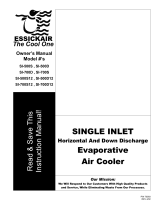
Evaporative Cooling
Evaporative cooling uses the principle of evaporation to lower the air temperature. Hot, dry air is passed through wetted
filters and is converted to refreshingly cooled air. Essick Coolers make the best use of the evaporative process by
controlling the flow of water, spreading the water evenly over the filters, and keeping a steady stream of cooled air
entering your home. It is exhausted out open windows or doors, carrying heat, smoke and odors along with it. Essick
evaporative coolers are 80% less costly to operate than refrigerated air conditioners.
Cautions: To prevent harm to yourself and others, and to avoid damage to your cooler, PLEASE follow these guidelines.
SAFETY GUIDE LINES & CAUTIONS
When Installing When Operating When Servicing
Make sure that unit is installed on a sound
structure that will support the full operating
weight of the cooler. See page 3.
Make sure that circuit cooler is wired into is
equipped with a (slow blow) breaker large
enough to support the full amperage of the
cooler.
Always shutoff power to the cooler, at the
breaker, before attempting service of any
kind. If not, it can be turned on from inside
the house and start unexpectedly.
Before attempting to transport the cooler to the
mounting location, plan a safe way to move the
cooler and remove the louvers to reduce weight.
To reduce the risk of fire or electrical shock, DO
NOT use this fan with any Solid-state speed
control device.
Never drain cooler water onto your roof.
Water residue may cause you to slip or may
stain your roof.
Do Not connect power to cooler before
installation is complete.
This cooler is equipped with an automatic
thermally protected motor. If it shuts off on its
own for any reason, it can restart without
warning.
If the motor shuts off because of thermal
overload, check into the problem
immediately. If allowed to continue,
permanent damage will occur.
When servicing or installing, always wear gloves,
protective eyewear, and other applicable safety
gear. Never wear slippery-soled shoes when
working on a roof.
Never use a cooler without connecting it to a
duct system or without a sturdy mesh guard over
the outlet.
Never install or service a cooler during a
storm or high wind conditions.
Tools & Materials Required
1. Pliers
2. Screwdrivers 2. Screwdrivers
3. Adjustable wrenches 3. Adjustable wrenches
4. Tubing cutter 4. Tubing cutter
5. 5/32 hex wrench 5. 5/32 hex wrench
6. Electric drill 6. Electric drill
7. Drill bits 7. Drill bits
8. Hammer 8. Hammer
9. Duct caulking 9. Duct caulking
10. #10 sheet metal screws 10. #10 sheet metal screws
11. Safety glasses 11. Safety glasses
12. Wiring supplies (as required by local electric
codes)
12. Wiring supplies (as required by local electric
codes)
13. Duct, as required. A local sheet metal shop can
supply ducting or it may be purchased as a kit.
13. Duct, as required. A local sheet metal shop can
supply ducting or it may be purchased as a kit.
14. Level 14. Level
15. Air diffuser 15. Air diffuser
16. Equipment suitable for cutting hole in roof or wall 16. Equipment suitable for cutting hole in roof or wall
17. ¼” water line 17. ¼” water line
18. saddle valve or faucet adapter 18. saddle valve or faucet adapter
19. ECR-6 wall switch (6 position) 19. ECR-6 wall switch (6 position)
20. Roof stand (if cooler is roof mounted) 20. Roof stand (if cooler is roof mounted)
Location
Location
1. Your cooler installation must comply with local codes. If you are not qualified to install a cooler, get professional help. 1. Your cooler installation must comply with local codes. If you are not qualified to install a cooler, get professional help.
2. Do not install the cooler near vent pipes, chimneys or exhaust pipes. The cooler will draw in fumes into your house. 2. Do not install the cooler near vent pipes, chimneys or exhaust pipes. The cooler will draw in fumes into your house.
3. The drain fitting in the bottom of the cooler must have adequate room for service access. 3. The drain fitting in the bottom of the cooler must have adequate room for service access.
Side discharge
connected to
duct work
Down discharge
into hall
70932
Rev. 6/02
2





















